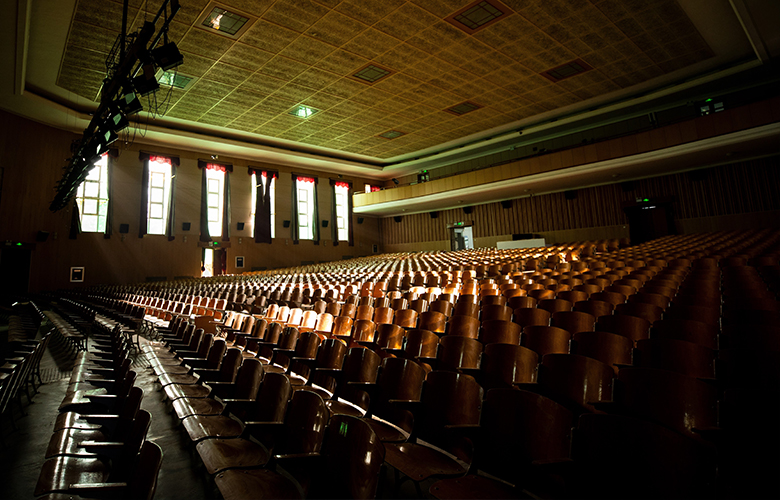
While many colleges had to switch to distance learning in the spring due to the rise of Covid-19, starting the new academic year in the Fall of 2020 was a very different obstacle. For most colleges, there was a sudden shift to utilize online tools to facilitate learning. What was thought to be a two or three week interim continued on through the rest of the spring semester. Students and faculty had no choice but to quickly adapt to the virtual classroom. Faculty had only a few goals in this transition: 1) continue regularly scheduled classes, 2) become flexible with virtual meetings, 3) keep up with new directions and requests from administration, and/or 4) decide the fate of current productions.
Despite the transitional concerns in the spring, more pedagogical concerns were coming with the new academic year. What would the fall semester look like? Many theater department faculty members remained fully engaged throughout the summer, exploring options for a successful 20-21 academic year. Ultimately, each university’s decision on remote or in-person learning shaped the theater department’s options. As the fall semester now comes to a close, looking back allows the opportunity to assess some of the biggest challenges. These pedagogical challenges during the fall semester required faculty to rediscover engagement in performance activities, and how it could be presented in the curriculum.
The first challenge theater departments had to surmount was whether (or “if”) it would be advantageous to produce theater in the fall semester. Of course, the uncertainty in making the right decision was complicated and depended on university Covid-19 regulations and an assessment of safety by each theater department. But, the ‘if’ led to asking, “Why?”
The first thought: Theater faculty will say that productions are considered half of the education; it is important to get out of the lecture hall and into the theater/shop to do the work, learn the choreography, hang lights, and build flats. Production is where students put their training into practice. Without producing shows, students lose the opportunity to use what they have learned, a very important facet of their education.
The second thought: Engagement is necessary in the theater community. Recruitment and retention suffer in a theater program that is not producing shows. Theater students are very active individuals who want to participate and engage. Without a production on which to work, student attention may be lost, and along with that comes decreased enrollment.
The second challenge is how to produce theater. At the cornerstone of theater is the live, actor-audience relationship. As Peter Brook states, “A man walks across this empty space whilst someone else is watching him, and this is all that is needed for an act of theater to be engaged” (Brooks). This is one of the most detrimental effects of Covid-19 for the theater industry.
A large majority of theater programs chose to stream their productions using the predominant platforms of Zoom, Youtube, and Vimeo. This required new technology and software. Faculty members had to use their time to learn about webcams, cameras, video switching software, and video graphics. In other cases, departments produced radio dramas, a close relative to theater. And, in extremely rare cases, departments held live performances with an audience.
The third challenge for theater faculty has been to adapt class curriculum. Much of the class work in theater is either performative, intimate, group work, or hands-on. It could be easy to turn most theater classes into lectures, but faculty members recognize that the heart of theater is based in active learning. Projects, scene work, activities, and monologues are fundamental to theater education. Faculty have had to recreate their courses to ensure the safety of each student and to preserve the active nature of the classroom. Like many other faculty members, summer was spent adapting assignments and projects. Thus, faculty had to re-invent lesson plans, find new digital tools, and implement other new methods of learning, all while preventing the new curriculum from becoming dull and mundane.
The fourth challenge for theater faculty has been perseverance and creative activities. Faculty have struggled to stay positive and engaged during this fall semester for several reasons. Since faculty have had to pull back from normal operation, they are wondering if effectiveness in classes has diminished. Faculty have also become disengaged from the craft due to the lack of freelance work. More administrative and janitorial responsibilities plague the faculty. And the biggest adversity is that most have not produced a show in over nine months. It has been hard for many to keep pushing forward. Theater educators don’t just teach, they also create theater in their community, with local and non-local companies, and with summer stock. Covid-19 has kept all faculty from this outside work. The more obvious answer for faculty is to bring their creative endeavors into the classroom and to work with students. Sadly, it is harder to answer the ‘how’ to do this.
If there is any advice that can be offered, it is this: Nothing right now is perfect; therefore, do not feel the need to meet that standard. All faculty members must continue to remain flexible, attempt to do their best, and remember that those who teach theater are champions of innovation. This may not be the best semester – or even the greatest academic year of a teaching career – but, looking back will reveal success in preserving this craft. The curtain has not gone down on theater; it has just been re-designed to fit this stage of life.
Works Cited
Brooks, Peter. The Empty Space. Scribner; Reprint Edition, 1995
Summer Stock: A Lab for Students


B.A. Palm Beach Atlantic University; MFA Florida State University. Dana White is an Assistant Professor at Palm Beach Atlantic University, teaching classes that focus on tech and design. Dana has also served as the Technical Director at Cortland Repertory Theatre. He is a passionate collaborator whose goal is to train his students to be the very best theatre practitioners. Dana focuses his training on technical skills, leadership, and communication. In his spare time, he enjoys board games and lazy days at the beach.
Read Full Profile© 2021 TheatreArtLife. All rights reserved.

Thank you so much for reading, but you have now reached your free article limit for this month.
Our contributors are currently writing more articles for you to enjoy.
To keep reading, all you have to do is become a subscriber and then you can read unlimited articles anytime.
Your investment will help us continue to ignite connections across the globe in live entertainment and build this community for industry professionals.